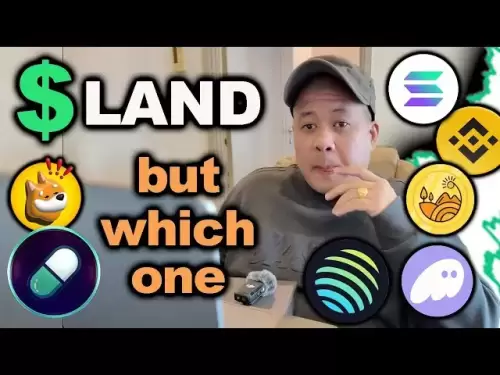-
 Bitcoin
Bitcoin $118600
0.36% -
 Ethereum
Ethereum $3855
1.06% -
 XRP
XRP $3.195
-0.09% -
 Tether USDt
Tether USDt $1.000
-0.04% -
 BNB
BNB $844.5
6.23% -
 Solana
Solana $191.3
2.83% -
 USDC
USDC $0.9997
-0.01% -
 Dogecoin
Dogecoin $0.2376
0.10% -
 TRON
TRON $0.3242
0.83% -
 Cardano
Cardano $0.8222
0.13% -
 Hyperliquid
Hyperliquid $45.26
6.53% -
 Sui
Sui $4.200
-2.56% -
 Stellar
Stellar $0.4336
-1.24% -
 Chainlink
Chainlink $18.86
0.28% -
 Hedera
Hedera $0.2796
-1.75% -
 Bitcoin Cash
Bitcoin Cash $583.3
-1.84% -
 Avalanche
Avalanche $27.06
8.09% -
 Litecoin
Litecoin $112.3
-1.16% -
 Toncoin
Toncoin $3.353
0.58% -
 UNUS SED LEO
UNUS SED LEO $8.968
-0.11% -
 Shiba Inu
Shiba Inu $0.00001395
-0.54% -
 Ethena USDe
Ethena USDe $1.001
-0.03% -
 Uniswap
Uniswap $10.76
0.69% -
 Polkadot
Polkadot $4.175
0.26% -
 Monero
Monero $326.7
1.07% -
 Bitget Token
Bitget Token $4.665
1.61% -
 Dai
Dai $0.9998
-0.02% -
 Pepe
Pepe $0.00001271
0.32% -
 Cronos
Cronos $0.1416
2.01% -
 Aave
Aave $299.3
1.15%
What does it mean when the K-line reverses after the long lower shadow touches the lower track of the Bollinger Band?
A K-line with a long lower shadow touching the Bollinger Band’s lower boundary may signal a bullish reversal, especially if confirmed by volume and oversold RSI.
Jul 28, 2025 at 11:15 pm

Understanding the Bollinger Band and K-line Dynamics
The Bollinger Band is a widely used technical analysis tool composed of three lines: a simple moving average (SMA) in the center, and upper and lower bands that represent standard deviations from that average. Traders use this indicator to assess volatility and identify potential price extremes. When the price touches or breaches the lower track of the Bollinger Band, it often signals that the asset is trading at a relatively low level compared to recent price action, potentially indicating oversold conditions.
The K-line, also known as the Japanese candlestick, provides visual insight into price movements within a given time frame. Each K-line displays the open, high, low, and close prices. A long lower shadow occurs when the price drops significantly during the period but then recovers to close near or above the opening price. This pattern suggests strong buying pressure emerged after a sell-off, potentially indicating a shift in market sentiment.
When a K-line with a long lower shadow touches the lower Bollinger Band and then reverses, it may reflect a temporary exhaustion of selling pressure. The reversal indicates that buyers have stepped in to defend the price level, preventing further downward movement. This confluence of technical signals—touching the lower band and forming a long lower shadow—can be interpreted as a potential short-term bullish reversal signal.
Significance of the Long Lower Shadow at the Lower Bollinger Band
A long lower shadow at the lower Bollinger Band is more than just a visual pattern—it carries psychological weight in market behavior. The fact that the price tested a level below the moving average but was pushed back up suggests that sellers initially dominated but were overwhelmed by buyers. This rejection of lower prices is a key element in reversal analysis.
- The lower Bollinger Band acts as a dynamic support level during downtrends.
- A touch or slight penetration of this band increases the likelihood of a bounce, especially if accompanied by volume confirmation.
- The long lower shadow shows that although bears attempted to push the price down, bulls regained control before the candle closed.
This combination suggests that the downward momentum is weakening. The longer the shadow relative to the body of the candle, the stronger the implication that buyers are stepping in. However, this signal gains more validity when it occurs in oversold conditions, particularly when confirmed by other oscillators like the Relative Strength Index (RSI) or Stochastic Oscillator.
How to Confirm the Reversal Signal
While the appearance of a long lower shadow touching the lower Bollinger Band is suggestive, it should not be acted upon in isolation. Confirmation is essential to reduce false signals.
- Look for the next candle to close above the low shadow’s high to confirm upward momentum.
- Check for increased trading volume during the reversal candle, as higher volume adds credibility to the move.
- Use RSI readings below 30 to validate oversold conditions, reinforcing the reversal possibility.
- Monitor for bullish candlestick patterns such as hammer, inverted hammer, or bullish engulfing following the long lower shadow.
Additionally, align the signal with the broader trend. A reversal at the lower band in a strong downtrend may only lead to a corrective bounce, not a full trend reversal. However, if the price has been consolidating near the lower band and then forms a long lower shadow followed by higher closes, it could indicate the start of a new uptrend.
Practical Steps to Trade This Pattern
To trade this setup effectively, precise execution is required. The goal is to enter early while minimizing risk.
- Identify the asset’s current volatility using the Bollinger Band width—narrow bands often precede strong moves.
- Wait for a K-line to form with a long lower shadow that touches or slightly breaches the lower band.
- Ensure the closing price is near the top of the candle’s range, indicating strong buyer conviction.
- Place a buy order at the high of the long lower shadow candle to confirm breakout strength.
- Set a stop-loss just below the low of the shadow to limit downside risk.
- Target the middle Bollinger Band (SMA) as the first profit zone, and the upper band as a secondary target.
Use trailing stops if the price continues to rise beyond the upper band. Avoid entering on the first touch of the lower band during high volatility events unless confirmed by volume and momentum indicators.
Common Misinterpretations and Risk Factors
Not every long lower shadow at the Bollinger Band leads to a successful reversal. Misreading this signal can result in losses, especially in strongly trending markets.
- In a strong downtrend, repeated touches of the lower band may not reverse but instead indicate continuation. Each long lower shadow could be a "sucker’s rally" where buyers enter prematurely.
- Low volume during the shadow formation reduces its reliability. Without participation, the rebound may lack follow-through.
- Widening Bollinger Bands suggest increasing volatility, which can lead to false breakouts or whipsaws.
- If the price closes below the lower band and remains there for multiple candles, it may signal a breakdown rather than a reversal.
Traders should also be cautious during major news events or macroeconomic announcements, as price movements may distort technical patterns. Always assess the overall market structure and avoid countertrend trades unless multiple indicators align.
Integrating This Signal into a Broader Strategy
This reversal pattern works best when combined with a comprehensive trading framework.
- Use support and resistance levels to determine if the Bollinger Band touch coincides with historical price floors.
- Apply Fibonacci retracement levels—a touch at the 61.8% or 78.6% retracement near the lower band strengthens the reversal case.
- Combine with moving average crossovers; for example, a bullish crossover of the 9-day and 21-day EMA following the shadow adds confirmation.
- Monitor market sentiment through on-chain data (for cryptocurrencies) or funding rates in futures markets.
Backtesting this pattern across different timeframes—such as 1-hour, 4-hour, and daily charts—helps assess its consistency. Adjust position size based on the strength of confluence among indicators.
Frequently Asked Questions
Can this signal occur in ranging markets?
Yes, in sideways or consolidating markets, the Bollinger Band often acts as a channel. A long lower shadow touching the lower band in such environments frequently leads to a bounce toward the middle or upper band, making it a reliable mean-reversion signal.
Does the length of the lower shadow matter?
Absolutely. A shadow at least twice the length of the candle body is considered significant. The longer the shadow, the greater the rejection of lower prices, indicating stronger buyer intervention.
Should I use this pattern on all cryptocurrencies?
This pattern is applicable across most liquid cryptocurrencies like Bitcoin and Ethereum, but caution is advised with low-volume altcoins. These assets are prone to manipulation and erratic moves, which can generate misleading signals.
What timeframes are best for spotting this reversal?
The 4-hour and daily charts provide the most reliable signals due to reduced noise. Shorter timeframes like 5-minute or 15-minute charts may show frequent touches but with lower accuracy and higher false signal rates.
Disclaimer:info@kdj.com
The information provided is not trading advice. kdj.com does not assume any responsibility for any investments made based on the information provided in this article. Cryptocurrencies are highly volatile and it is highly recommended that you invest with caution after thorough research!
If you believe that the content used on this website infringes your copyright, please contact us immediately (info@kdj.com) and we will delete it promptly.
- Avalanche (AVAX) Price Pump Incoming? Analysts Weigh In
- 2025-07-29 06:50:12
- Presales, Investment, July 2025: What's Hot and What's Not
- 2025-07-29 06:30:12
- PayPal, Bitcoin, and Merchants: A New Era of Commerce?
- 2025-07-29 07:10:13
- RUVI Token's Ripple Rally Potential: Audited AI Crypto Heats Up!
- 2025-07-29 04:50:12
- ADA Price, Cardano, SUI & Remittix: Decoding the Latest Crypto Moves
- 2025-07-29 04:50:12
- Solana, ARK Invest, and Staking: A New Era of Institutional Crypto?
- 2025-07-29 05:30:12
Related knowledge

What does it mean when the EMA combination crosses upward for the first time after sideways trading?
Jul 28,2025 at 03:43pm
Understanding the EMA and Its Role in Technical AnalysisThe Exponential Moving Average (EMA) is a widely used technical indicator in cryptocurrency tr...

What signal does the ROC send when it rises rapidly from a low level and breaks through the zero axis?
Jul 27,2025 at 10:15am
Understanding the Rate of Change (ROC) IndicatorThe Rate of Change (ROC) is a momentum-based oscillator used in technical analysis to measure the perc...

What does it mean when the price breaks through the double bottom neckline and the moving averages are arranged in a bullish pattern?
Jul 28,2025 at 10:57am
Understanding the Double Bottom PatternThe double bottom is a widely recognized reversal chart pattern in technical analysis, particularly within the ...

What signal does the DMA fast line cross the slow line above the zero axis?
Jul 28,2025 at 05:42am
Understanding the DMA Indicator and Its ComponentsThe DMA (Difference of Moving Averages) indicator is a technical analysis tool used in cryptocurrenc...

What does it mean that the rebound is blocked after the moving average is arranged in a short position for the first time?
Jul 26,2025 at 10:51am
Understanding the Short-Term Moving Average ConfigurationWhen traders refer to a 'short position arrangement' in moving averages, they are describing ...

What does it mean that the ZIGZAG low point is raised and the high point breaks through the previous peak?
Jul 28,2025 at 03:28am
Understanding the ZIGZAG Indicator in Cryptocurrency TradingThe ZIGZAG indicator is a technical analysis tool widely used in cryptocurrency trading to...

What does it mean when the EMA combination crosses upward for the first time after sideways trading?
Jul 28,2025 at 03:43pm
Understanding the EMA and Its Role in Technical AnalysisThe Exponential Moving Average (EMA) is a widely used technical indicator in cryptocurrency tr...

What signal does the ROC send when it rises rapidly from a low level and breaks through the zero axis?
Jul 27,2025 at 10:15am
Understanding the Rate of Change (ROC) IndicatorThe Rate of Change (ROC) is a momentum-based oscillator used in technical analysis to measure the perc...

What does it mean when the price breaks through the double bottom neckline and the moving averages are arranged in a bullish pattern?
Jul 28,2025 at 10:57am
Understanding the Double Bottom PatternThe double bottom is a widely recognized reversal chart pattern in technical analysis, particularly within the ...

What signal does the DMA fast line cross the slow line above the zero axis?
Jul 28,2025 at 05:42am
Understanding the DMA Indicator and Its ComponentsThe DMA (Difference of Moving Averages) indicator is a technical analysis tool used in cryptocurrenc...

What does it mean that the rebound is blocked after the moving average is arranged in a short position for the first time?
Jul 26,2025 at 10:51am
Understanding the Short-Term Moving Average ConfigurationWhen traders refer to a 'short position arrangement' in moving averages, they are describing ...

What does it mean that the ZIGZAG low point is raised and the high point breaks through the previous peak?
Jul 28,2025 at 03:28am
Understanding the ZIGZAG Indicator in Cryptocurrency TradingThe ZIGZAG indicator is a technical analysis tool widely used in cryptocurrency trading to...
See all articles

























































































